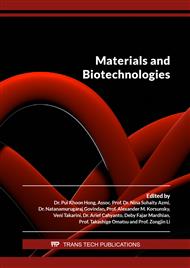[1]
A. N. Kamarudzaman, C. C. Tay, M. F. A. Jalil, S. A. Talib. Biosorption of iron(III) from aqueous solution using Pleurotus ostreatus spent mushroom compost as biosorbent. Advanced Materials Research, (2013) 781-784.
DOI: 10.4028/www.scientific.net/amr.781-784.636
Google Scholar
[2]
A. Jasińka. Spent mushroom compost (SMC) – retrieved added value product closing loop in agricultural production. Acta Agraria Debreceniensis, (2018) 185-202.
DOI: 10.34101/actaagrar/150/1715
Google Scholar
[3]
Information on http://www.fao.org/faostat/en/#data/TP.
Google Scholar
[4]
Information on http://www.doa.gov.my/index.php/pages/view/622?mid=239.
Google Scholar
[5]
N.A. Umor, S. Ismail, S. Abdullah, Zero waste management of spent mushroom compost. Journal of Material Cycles and Waste Managemen, 23 (2021).
DOI: 10.1007/s10163-021-01250-3
Google Scholar
[6]
D. S. Avneesh, N. Abdullah, S. Vikineswary, Optimization of extraction of bulk enzymes from spent mushroom compost. Journal of Chemical Technology and Biotechnology, (2003) 743-752.
DOI: 10.1002/jctb.852
Google Scholar
[7]
I. Uzun, Use of spent mushroom compost in sustainable fruit production. Journal of Fruit and Ornamental Plant Research, 12 (2004) 157-165.
Google Scholar
[8]
S. N. Jordan, G. J. Mullen, M. C. Murphy.,Composition variability of spent mushroom compost in Ireland. Bioresource technology, (2008) 411-418.
DOI: 10.1016/j.biortech.2006.12.012
Google Scholar
[9]
K. Espiritu, L. Nielsen, Mushroom Compost: What It Is, What It Does, And How to Make It,. 18 March 2019, from http://www.epicgardening.com/mushroom-compost.
Google Scholar
[10]
A. O. Nadia, O. Salim, M. Nassima, I. Yamina, H. Dolores, M. S. Carla, Bioactibe metabolites involved in antioxidant anticancer and anticalpain activities of Ficus carica L., Ceratonia siliqua L. and Quercus ilex L. extracts. Industrial Crops and Production, (2017). 6-17.
DOI: 10.1016/j.indcrop.2016.10.007
Google Scholar
[11]
S. Mawa, K. Husain, I. Jantan, Ficus carica L. (Moraceae): Phytochemistry, traditional uses and biological activities. Evidence-Based Complementary and Alternative Medicine, (2013) 1-8.
DOI: 10.1155/2013/974256
Google Scholar
[12]
N. Bouhouche, T. Ksiksi, An efficient in vitro plant regeneration system for medicinal plant Teucrium stocksianum Boiss. Plant Biotechnology Report, (2007) 179-184.
DOI: 10.1007/s11816-007-0033-4
Google Scholar
[13]
S.H. Tan, M. Maziah, A.B. Ariff, Synergism effect between inoculum size and aggregatesize on flavonoid production in Centella asiatica (L.) urban (pegaga) cell suspension cultures. International Journal of Research in Engineering and Technology, 2(8) (2013) 244-253.
DOI: 10.15623/ijret.2013.0210037
Google Scholar
[14]
D. Djilianov, G. Genova, D. Parvanova, N. Zapryanora, T. Konstantinova, A. Atanassov, In vitro culture of resurrection plant Haberlea rhodopensis. Plant Cell, Tissue and Organ Culture, (2005) 115-118.
DOI: 10.1007/s11240-004-8835-3
Google Scholar
[15]
D.P. Stewart, K. C. Cameron, I. S. Cornforth, Main Release of sulphate, potassium, calcium and magnesium from spent mushroom compost under laboratory conditions. Biology Fertile Soils, (1998) 146-151.
DOI: 10.1007/s003740050358
Google Scholar
[16]
C. C. Tay, S. Mohamad, N. Wan, N. Saiyidah, Pleurotus spent mushroom compost as green supplementary nutrient in tissue culture. MATEC Web of Conferences 47, (2016) 45-46.
DOI: 10.1051/matecconf/20164705010
Google Scholar
[17]
F. Tei, S. Nicola, P. Benincasa, Book: Advances in research on fertilization management of vegetable crops. Advances in Olericulture. (2017).
DOI: 10.1007/978-3-319-53626-2
Google Scholar
[18]
J. Jani, S. Jha, D. Nagar, Root explant produces multiple shoot from pericycle in Psoralea corylifolia-a leprosy destroyer medicinal plant. Science Horticulturae, (2006) 332-336.
DOI: 10.1016/j.indcrop.2015.02.001
Google Scholar
[19]
A. Ortuno, L. Diaz, I. Perez, F. Sanchez, J. Rio, Biological active compounds from Limonium insigne and alternative methods for its micropropagation. Scientia Horticulturae , (2018) 78-85.
DOI: 10.1016/j.scienta.2017.11.022
Google Scholar
[20]
Z.C. Ng, S.H.R.S. Mahmud, S.H. Tan, Effects of Cytokinin in Enhancing the Multiplication of Vegetative Hylocereus polyrhizus. Materials Science Forum, 1028, (2021) 97-103.
DOI: 10.4028/www.scientific.net/msf.1025.97
Google Scholar
[21]
W. N. H. W. Anuar, S. H. Tan, S. H. R. S. Mahmud, W. N. M. Norazmi, E. F. S. E. Safruddin. Enhancement Effect of BAP and Spent Mushroom Compost in Micro-Propagation of Sabah Snake Grass. 15 (4), (2019) 190-197.
DOI: 10.3844/ajbbsp.2019.190.197
Google Scholar



